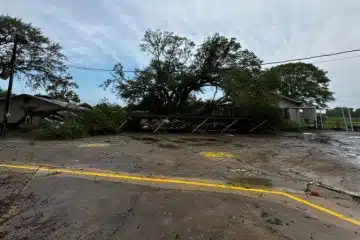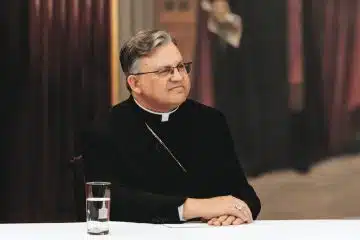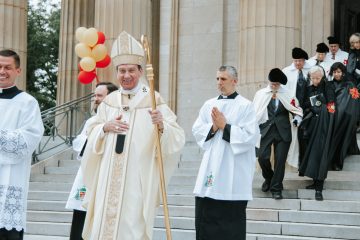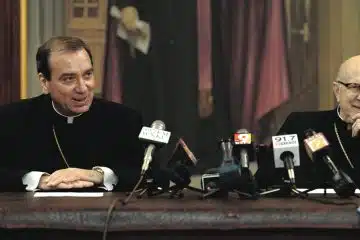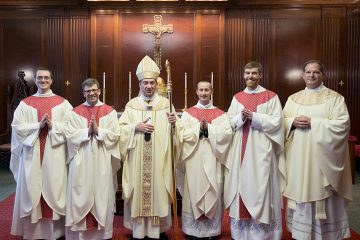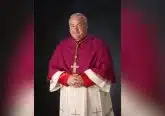Claiming ‘sanctuary’ in the current immigration climate
By Rhina Guidos
WASHINGTON (CNS) — Throughout the U.S., cities, states, places of worship, university campuses and religious communities have been publicly declaring themselves as places of “sanctuary” for migrants, particularly for those who have voiced fears and worries about stepped-up deportation efforts from the Immigration and Customs Enforcement, known as ICE.
Their fears were stoked when Donald Trump became president and said he would deport the estimated 11 million unauthorized immigrants in the U.S., issuing new guidelines that expanded the pool targeted for deportation.
Among members of the Catholic Church, some officials as well as parishioners and others have said they will protect their brothers and sisters from the anti-immigrant sentiments brewing as well as from deportation threats. Some declared themselves “sanctuary” spaces as a way to express to immigrants that regardless of their status, they’re safe, welcome and protected among them.
While the intention to protect members of a faith community may be real, there’s little legal protection to be found in declaring sanctuary and, in some cases, it may even attract unwanted attention.
“It just basically is a signal to immigrants that they can come there and feel protected although in truth, they aren’t,” said Kevin Appleby, senior director of international migration policy at the Center for Migration Studies of New York. “It really has no legal standing.”
Publicly declaring sanctuary is not advisable, said Appleby, because it can make a church a “target for ICE.”
Though it’s not a law, under President Barack Obama, the Department of Homeland Security, which operates ICE, issued a memo in 2011 saying agents would respect “sensitive locations,” and not apprehend immigrants at those sensitive locations, which include churches and other places of worship. But that policy came into question when immigration officials in February apprehended a group of homeless men at a church-run hypothermia shelter in Alexandria, Virginia.
While there aren’t a lot of rock-solid assurances that a church or church organization can give on what can and can’t happen on “sanctuary” grounds, what officials can say is: “We’ll do everything within the law to protect you,” said Appleby. That means doing something similar to what the Archdiocese of Chicago did when it asked priests as well as principals of Catholic schools in the archdiocese to not allow immigration officials on church grounds without a warrant.
“If they do not have a warrant and it is not a situation that someone is in imminent danger, tell them politely they cannot come on the premises,” Chicago Cardinal Blase J. Cupich wrote in a letter issued in late February, addressing the matter with staff.
“That’s all legal and basically makes them (immigration agents) do everything they have to do in order to pursue someone and there’s nothing wrong with that,” Appleby said.
Ultimately, law enforcement has the right to detain and deport a person, and if they have probable cause that someone’s in the church that they need to apprehend, they can step on to its property and do so, Appleby said, even if that space has declared itself a “sanctuary.”
But “sanctuary” in 2017 can mean a lot of different things, said Ashley Feasley, policy director for Migration and Refugee Services at the U.S. Conference of Catholic Bishops in Washington.
“It does not have to be just the physical act of providing shelter,” she said. “Sanctuary can be other forms of relief and support.”
Feasley said a “sanctuary” space may mean it’s a place where migrants can find pastoral accompaniment, education and awareness to help them navigate uncertain waters. A “sanctuary” parish can mean that it can help immigrants with legal screenings, with presentations that teach them about their rights, what to say what not to say, how to register with consulates, how to create a family preparation plan in case a member is apprehended, she said.
They also can become places where parishioners organize to bring the plight of unauthorized immigrants to the attention of local and federal lawmakers and fight for their protection, she said. Recently, Feasley said, Congress has been looking at a bill that would make the “sensitive location” policy a law, meaning it couldn’t be ignored at will by immigration agents.
“It is important that elected officials know this is a top issue to Catholics and community members in general,” Feasley said.
But others fear that all those actions may not be enough should deportation efforts increase. Some are preparing for a “sanctuary movement” similar to the one that protected refugees fleeing civil wars in Central America in the 1980s.
If the country begins to see mass deportations of people who haven’t committed major crimes, or groups such as minors who were to brought the U.S. without legal permission, it’s not out of the question to start seeing something similar to the sanctuary movement of the past, Appleby said, but even back then, the movement wasn’t something that was sanctioned by the church.
Back then, parishes, church members, certain priests and religious, were housing and protecting refugees fleeing the turmoil of places such as Guatemala and El Salvador, which were involved in civil wars. In 1984, a Catholic sister, Sister Dianne Muhlenkamp of Indiana, along with a social worker from another faith community, was arrested in Texas while driving a car belonging to the Diocese of Brownsville in which she was transporting Salvadorans fleeing the war.
Around the country, some members of faith communities, including Jewish and evangelical groups, are organizing for more of the same. Some have formed “rapid response teams,” which would not only help families in danger of deportation, but also provide legal help to look at their options.
Appleby said what might be helpful to do, given the lack of clarity about what will and won’t happen on the immigration front, is to be prepared at the parish level and at the diocesan level for what to do in case any number of scenarios take place.
Beside preparing for what to do should immigration officials arrive on church property without a warrant, church officials also may want to prepare for the possibility in which an unauthorized immigrant enters a church and requests sanctuary, he said.
If the person “enters a church and says, ‘I’m not leaving,’ and then it draws media attention, it draws the bishop’s attention, and the bishop and his staff need to really understand what the law is in this regard,” Appleby said. Bishops or others in the diocese may end up in the unusual position of acting as a go-between with immigration agents on one side and the person seeking protection on the other, he said.
Right now is good time to share information among like-minded communities of faith, said Feasley, letting others know what church staff, or other organizations, can do and letting immigrants know their rights, and what to do should an unusual event involving immigration occur on church property grounds.
The church’s position, said Appleby, is not so much to provide sanctuary but to provide vigilance to protect the rights of immigrants to the degree that the law allows. The church is not in the business of asking people for immigration documents to worship, he said, but it can say “we offer a welcoming environment to all regardless of their legal status.”
– – –
Follow Guidos on Twitter: @CNS_Rhina.
– – –
Copyright © 2017 Catholic News Service/U.S. Conference of Catholic Bishops. www.catholicnews.com. All rights reserved. Republishing or redistributing of CNS content, including by framing or similar means without prior permission, is prohibited. You may link to stories on our public site. This copy is for your personal, non-commercial use only. To request permission for republishing or redistributing of CNS content, please contact permissions at [email protected].



